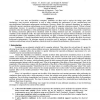Free Online Productivity Tools
i2Speak
i2Symbol
i2OCR
iTex2Img
iWeb2Print
iWeb2Shot
i2Type
iPdf2Split
iPdf2Merge
i2Bopomofo
i2Arabic
i2Style
i2Image
i2PDF
iLatex2Rtf
Sci2ools
91
Voted
HPCA
2003
IEEE
2003
IEEE
A Statistically Rigorous Approach for Improving Simulation Methodology
Due to cost, time, and flexibility constraints, simulators are often used to explore the design space when developing a new processor architecture, as well as when evaluating the performance of new compiler-based and microarchitectural performance-enhancement mechanisms. However, despite this continued dependence on simulators, statistically rigorous simulation methodologies are not typically used for computer architecture research. Without a formal methodology, however, it is possible to underemphasize the effect of parameter interactions when choosing processor parameter values for simulations or when performing sensitivity analyses. A formal methodology can provide a sound basis for drawing conclusions gathered from simulation results by adding statistical rigor and, consequently, can increase confidence in the simulation results. This paper demonstrates the application of a rigorous statistical technique to the setup and analysis phases of the simulation process. Specifically, we ...
Computer Architecture | HPCA 2003 | Key Processor Parameters | Processor Parameter Values | Processor Performance Enhancements |
Related Content
| Added | 01 Dec 2009 |
| Updated | 01 Dec 2009 |
| Type | Conference |
| Year | 2003 |
| Where | HPCA |
| Authors | Joshua J. Yi, David J. Lilja, Douglas M. Hawkins |
Comments (0)

